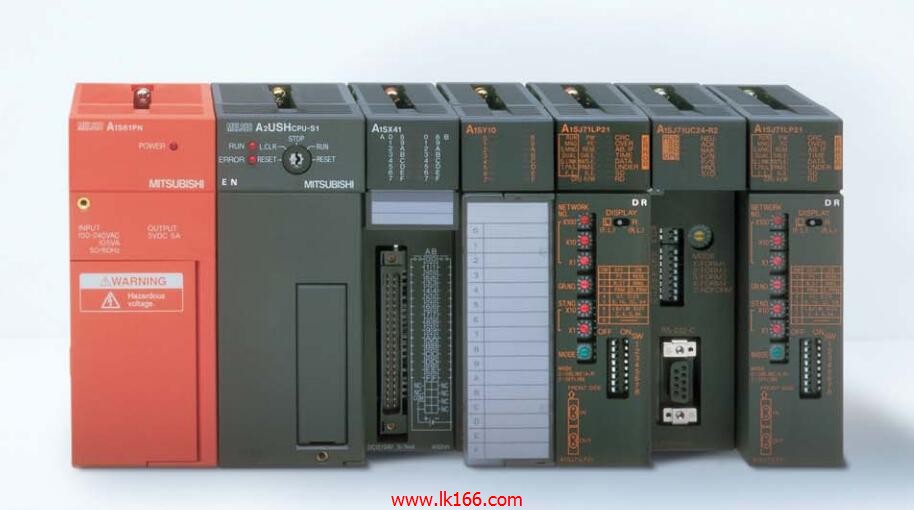A1SJ-56DT MITSUBISHI A1SJ-56DT DC input / crystal output module

Output points: 8 points.
Output voltage and current: 0.5A/1, DC5/12/24V point.
Response time: 2ms.
8 point /1 a public side.
Output form: transistor output, leakage type.
26 point terminal station.
Number of stations: 1 stops.
Equipment layer / field bus CC-Link device layer is the PLC and other control devices and sensors and drive devices conneected to the field network,
Network for the lowest layer of the whole network system A1SJ-56DT.
Using CC-Link field bus connection, the number of wiring is greatly reduced,
Improve the maintainability of the system A1SJ-56DT.
And, not just the amount of data ON/OFF and other switches,
Can also be connected to the ID system, bar code reader, inverter, man-machine interface and other intelligent devices,
From the completion of a variety of data communication, the management of the terminal production information can be realized,
On the centralized management of the state of the machine movement,
Make maintenance work efficiency also greatly improved A1SJ-56DT.
Q series PLC in the use of CC-Link function better,
And easier to use MITSUBISHI A1SJ-56DT.
Mitsubishi Co PLC network inherited the traditional use of the MELSEC network,
And make it better in terms of performance, function, easy to use etc..
Provides a layer of three layers of clear network, to provide the most suitable network products for a variety of uses MITSUBISHI A1SJ-56DT.
The information layer /Ethernet (Ethernet) information layer is the highest level of the network system,
Mainly in the PLC, the device controller and production management with PC transmission between production management information, quality management information and the operation of equipment, etc MITSUBISHI A1SJ-56DT.,
Information layer using the most common Ethernet.
It is not only able to connect the PC system UNIX, windows system, etc.,
And can connect a variety of FA devices.
The Ethernet module has the function of Internet e-mail receiving and sending,
The user can send and receive the production information conveniently in any place of the world,
Build a remote monitoring management system.
At the same time, the use of the Internet FTP server functions and MELSEC protocol can be very easy to achieve the program upload / download and transfer of information. The most appropriate temperature regulation control (PID control) is possible,
In order to control the PID does not need to specify a special command.
In addition, according to the automatic regulation function,
The automatic setting of PID number is possible.
The length of time required to execute the instruction, the length of the user''s program, the type of instruction, and the speed of the CPU execution are very significant,
Generally, a scanning process, the fault diagnosis time,
Communication time, input sampling and output refresh time is less,
The execution time is accounted for the vast majority of.
The response time of PLC is the interval between the time of the change of the external output signal of the PLC and the time of the change of the external output signal which is controlled by it,
Lag time, this is the time constant of the input circuit,
The time constant of the output circuit, the arrangement of the user statement and the use of the instruction,
The cycle scan mode of PLC and the way of PLC to refresh the I/O and so on.
This phenomenon is called the I/O delay time effect.
Input points: 32 points.
Input voltage and current: 7mA DC24V.
Input response time: 10ms.
16 point /1 a public side.
Positive pole sharing.
Output points: 24 points.
Output voltage: DC24V.
OFF leakage current: 0.1mA.
Output response time: 12ms.
Output type: transistor output.
8 point /1 a public side.
With the surge absorber.
34 point terminal station.
PLC is introduced by the relay control technology after the development of micro processing technology,
Can be easily and reliably used for switching control.
As the analog quantity can be converted into digital quantity, the number of digital quantity is just a number of switching value,
Therefore, after the conversion of analog, PLC can also be reliable for processing control.
Because the continuous production process often has the analog quantity, the analog quantity control is sometimes called process control.
Analog quantity is not electricity, and PLC can only handle digital quantity, quantity of electricity.
All to realize the conversion between them to have the sensor, the analog quantity into a number of power.
If this power is not standard, but also through the transmitter,
The non-standard power into a standard electrical signal, such as 1-5V, 4-20mA, 0-10V, etc..
At the same time, there is also an analog input unit (A/D),
Transform these standard electrical signals into digital signals,
The analog output unit (D/A), in order to transform the digital quantity after PLC processing into analog quuantity -- standard electric signal A1SJ-56DT.
So the standard telecommunication number, the conversion between the number of operations to use a variety of computing.
This requires the resolution of the analog unit and the standard electrical signal.
